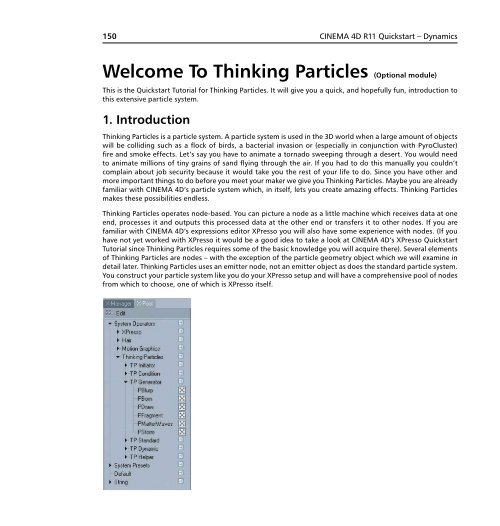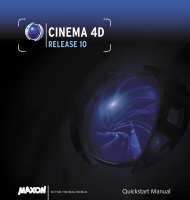Optional module - Maxon Computer
Optional module - Maxon Computer
Optional module - Maxon Computer
You also want an ePaper? Increase the reach of your titles
YUMPU automatically turns print PDFs into web optimized ePapers that Google loves.
150 CINEMA 4D R11 Quickstart – Dynamics<br />
Welcome To Thinking Particles (<strong>Optional</strong> <strong>module</strong>)<br />
This is the Quickstart Tutorial for Thinking Particles. It will give you a quick, and hopefully fun, introduction to<br />
this extensive particle system.<br />
1. Introduction<br />
Thinking Particles is a particle system. A particle system is used in the 3D world when a large amount of objects<br />
will be colliding such as a flock of birds, a bacterial invasion or (especially in conjunction with PyroCluster)<br />
fire and smoke effects. Let’s say you have to animate a tornado sweeping through a desert. You would need<br />
to animate millions of tiny grains of sand flying through the air. If you had to do this manually you couldn’t<br />
complain about job security because it would take you the rest of your life to do. Since you have other and<br />
more important things to do before you meet your maker we give you Thinking Particles. Maybe you are already<br />
familiar with CINEMA 4D’s particle system which, in itself, lets you create amazing effects. Thinking Particles<br />
makes these possibilities endless.<br />
Thinking Particles operates node-based. You can picture a node as a little machine which receives data at one<br />
end, processes it and outputs this processed data at the other end or transfers it to other nodes. If you are<br />
familiar with CINEMA 4D’s expressions editor XPresso you will also have some experience with nodes. (If you<br />
have not yet worked with XPresso it would be a good idea to take a look at CINEMA 4D’s XPresso Quickstart<br />
Tutorial since Thinking Particles requires some of the basic knowledge you will acquire there). Several elements<br />
of Thinking Particles are nodes – with the exception of the particle geometry object which we will examine in<br />
detail later. Thinking Particles uses an emitter node, not an emitter object as does the standard particle system.<br />
You construct your particle system like you do your XPresso setup and will have a comprehensive pool of nodes<br />
from which to choose, one of which is XPresso itself.









